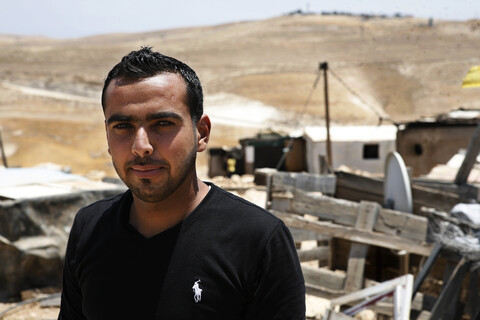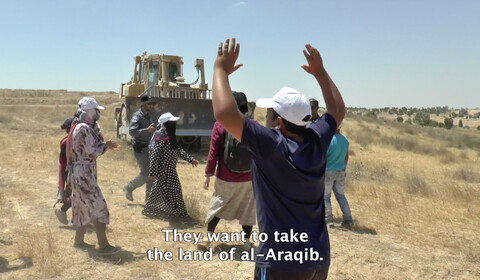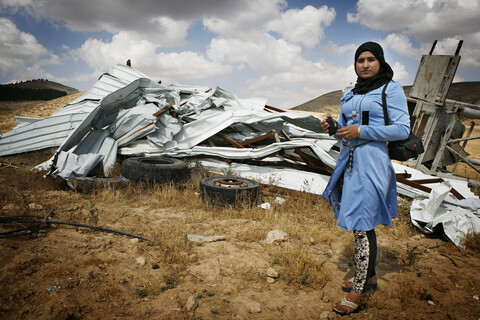The Electronic Intifada 24 May 2016

This building at N.2 Magen Avraham was previously a small hotel built by Tawfiq Abu-Ghazaleh and owned by the Abu-Ghazaleh family, which is today scattered in Egypt and Jordan. The previous name of the street was al-Malik Ghazi.
In mid-May, when Israeli Jews celebrate Independence Day, Palestinians commemorate the Nakba — the ethnic cleansing of hundreds of thousands of people from cities and villages across Palestine that began in December 1947 and intensified throughout 1948, both before and after the declaration of the State of Israel.
This process of removing Palestinians from their land continues in various forms to this very day.
Palestinian refugees as a whole have never been allowed to exercise their right to return to their homeland.
The Israeli group Zochrot aims “to promote the Jewish Israeli public’s responsibility for the ongoing Nakba and to exercise the Palestinian refugees’ right of return as its necessary historical redress.” Zochrot uses the May anniversary to show the connection between the “independence” of one group of people and the dispossession of another.
“Government authorities are stepping up the erasure process that has been happening since the Nakba,” Zochrot’s Niva Grunzweig told The Electronic Intifada. “They can see that people are asking questions and they are afraid of what might happen if the truth comes out.”
Zochrot’s Houses Beyond the Hyphen initiative takes up Jaffa, the historical Palestinian city currently obscured by the Tel Aviv-Yafo hyphen, as the site of a series of video installations in private homes and walking tours that uncover what has been happening there since 1948.
The coastal city, known as the Bride of the Sea, was once home to Palestine’s urban elite, and a cosmopolitan center of Arab culture. But after the fall of Jaffa in May 1948 following months of siege and bombardment, its character was drastically changed and its history systematically erased.
After a period of military occupation followed by decades of neglect, Jaffa is once again being reshaped by aggressive gentrification driving out many of its remaining Palestinian inhabitants.
Silvia Boarini is a photojournalist based in Bir al-Saba and is currently working on a documentary about Naqab Bedouins.

After the declaration of the State of Israel, the Custodian of Absentee Properties seized buildings owned by expelled Palestinians. The Abu-Ghazaleh hotel was divided into small apartments and rented to Jewish families.

The identity document belonging to a Jaffa native named Talal Abu-Ghazaleh, born in the city in 1938 and now a prominent businessman living in Jordan. In 1948, Abu-Ghazaleh and his family, along with thousands of other residents, left Jaffa by sea for exile in Lebanon.

The 3,000-4,000 Palestinians who managed to remain in the city after the Nakba lived under military rule and curfew until the summer of 1949 in what became known to both Jews and Palestinians as the Jaffa Ghetto. As most were unable to register ownership of their property, their buildings were usually given by the State of Israel to public housing companies. Palestinians who eventually were able to return to their homes would often find Jewish families living in them.

Viewers in the entrance hall of the former Abu-Ghazaleh hotel at N.2 Magen Avraham St. watch a video installation by Palestinian artists Scandar Copti and Rabi’ Buchari, who reminisce with friends about their days in a local Christian French private school.

Original features are still visible throughout the Abu-Ghazaleh building, which has never undergone major renovation.

One of the flats hosting a video installation by Scandar Copti and Rabi’ Buchari.

The original metal rail adorning the staircase at N.2 Magen Avraham.

Jaffa port — the point of arrival for many Jews and from which thousands of Palestinians were forced out or fled — is one of the stops on Zochrot’s tour “Empty Facade - On Erasure and Reconstruction in Jaffa.” This public installation places Jaffa at the center of nearby Mediterranean destinations. Those same cities are where many Palestinian refugees fled to, such as Beirut, Gaza and Alexandria.

A photograph from the 1930s shows Jaffa’s al-Dabbagh mosque as it used to be. The mosque was shut down in 1948 and the minaret torn down in 1992. Only five mosques remain in use in Jaffa today.

Plans for the destruction of Jaffa’s Old City were already being drawn up in the 1950s when Romanian-born artist Marcel Janco, who had already established an artists’ colony in Ein Hod on top of the ruins of the Palestinian village of Ein Hawd, proposed to develop it as a tourist attraction. The reconstructed alleys have received names with a zodiac theme.

The name “Maronite Quarter” references a nearby Maronite church, lending a sense of “authenticity” to the residential development. Church properties were rarely confiscated by Israeli authorities as it was felt that the Christian Palestinian minority had powerful allies abroad. This was also part of the Israeli state’s divide-and-conquer approach previously adopted in Palestine by the British. Real estate or land owned by churches is today highly valuable and often sold or leased to developers.

The building housing the Israeli army radio station was taken over by the army shortly after May 1948 and became its radio station headquarters in 1958.

Original features like this doorway have been incorporated into new projects which are changing the face of Jaffa.

A lonely mulberry tree. Fruit trees are an indication of unacknowledged past Palestinian presence. Fruit orchards were a common sight outside of Jaffa’s Old City especially before new Palestinian neighborhoods began to develop in the 1920s and ’30s. Across present-day Israel, ancient orchards and cultivated fruit trees can be found but the Palestinian villages and homes they belonged to have been erased.

A building dating back to the 1930s which was taken over by the army after the 1948 conquest and now sits abandoned.

The Andromeda luxury housing project and an ancient wall next to it. In Jaffa, economics is being used as a tool of dispossession. The most affluent Palestinian families fled Jaffa during the war; the few thousand residents who stayed were denied economic opportunity and remained poorer than the Jewish population. Residential projects such as this tend to exclude Jaffa’s disenfranchised Palestinian population.

Before 1948, Jaffa’s neighborhoods extended to the space now occupied by the tall buildings in the background of this photo, well into what is now considered Tel Aviv.




